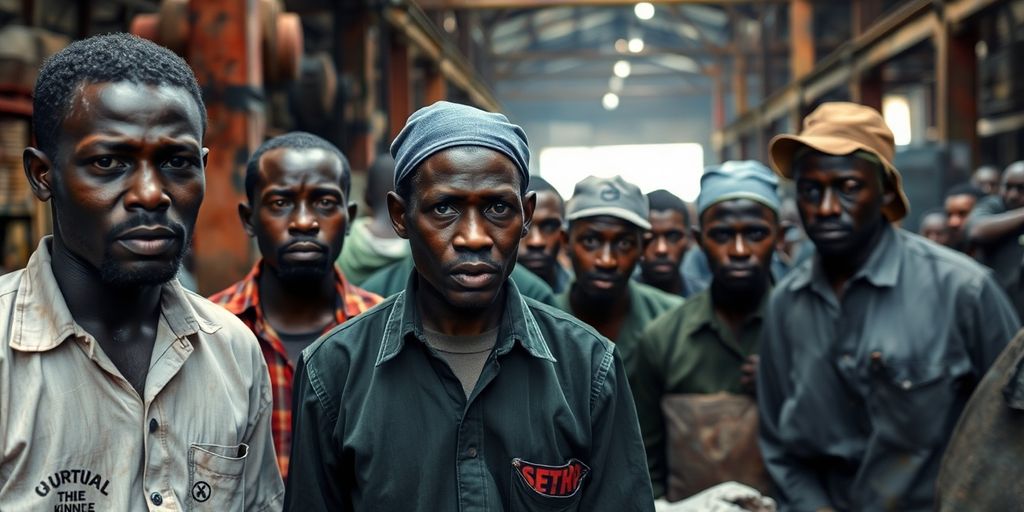Canada’s Temporary Foreign Worker Program (TFWP) has been under scrutiny for its treatment of migrant workers, particularly those from Nigeria. While the program aims to fill labor shortages, it often leaves workers vulnerable to exploitation and abuse. This article explores the various facets of this issue, shedding light on the challenges and systemic problems faced by Nigerian laborers in Canada.
Key Takeaways
- The TFWP is designed to address labor shortages but often results in the exploitation of workers, especially from Nigeria.
- Nigerian workers face significant challenges, including cultural barriers and fear of deportation, which prevent them from reporting abuse.
- Closed work permits restrict workers’ ability to change employers, making them vulnerable to mistreatment.
- Reports from organizations like Amnesty International highlight serious abuses in low-wage sectors involving temporary foreign workers.
- Advocacy groups are crucial in providing support and raising awareness about the rights of temporary foreign workers in Canada.
Understanding Canada’s Temporary Foreign Worker Program
Overview of the TFWP
Okay, so the Temporary Foreign Worker Program (TFWP) in Canada? It’s a big deal. Basically, it lets Canadian employers hire foreign workers to fill temporary jobs when they can’t find Canadians or permanent residents to do the work. It sounds simple, but it’s actually pretty complex. Lots of different rules and regulations. The program covers a range of jobs, from farm work to high-skilled tech positions. It’s supposed to be a last resort, but you see TFWs in many sectors.
Purpose and Goals of the Program
The TFWP is supposed to address labor shortages and help the Canadian economy. The main goal is to fill jobs that Canadians can’t or won’t do. The idea is that these workers contribute to the economy while they’re here, and then they go back home. But, it’s not always that straightforward. There’s a lot of debate about whether it actually helps or hurts Canadian workers. Some say it drives down wages and takes jobs away from Canadians. Others argue that it fills essential roles and keeps businesses running.
Critiques of the Program’s Structure
Okay, so here’s where things get a bit dicey. The TFWP has faced a lot of criticism over the years. One of the biggest issues is the potential for exploitation. Because workers are often tied to a specific employer, they can be vulnerable to abuse. If they complain or try to leave, they risk losing their job and being deported. Amnesty International actually put out a report recently highlighting how the structure of Canada’s TFWP leaves workers open to abuse and discrimination. It’s a pretty damning assessment. Also, there are concerns about whether the program is really addressing labor shortages or just providing cheap labor for employers.
The program’s structure, particularly the closed work permit system, is often criticized for creating an imbalance of power between employers and workers. This can lead to situations where workers are afraid to speak out against unfair treatment for fear of losing their jobs and immigration status.
Here’s a quick rundown of some common criticisms:
- Exploitation of workers
- Downward pressure on wages
- Lack of adequate oversight
- Limited pathways to permanent residency
The Vulnerability of Nigerian Workers
Reasons for Migration to Canada
For many Nigerians, the decision to migrate to Canada through the Temporary Foreign Worker Program (TFWP) is rooted in a desire for better economic opportunities and improved living conditions. High unemployment rates and limited career advancement prospects in Nigeria push many to seek employment abroad. The promise of higher wages, even in low-skilled jobs, can be a significant draw. Furthermore, the perception of Canada as a stable and safe country with a well-established legal system adds to its appeal. However, this eagerness to find better opportunities can make Nigerian workers particularly vulnerable to exploitation.
Challenges Faced by Nigerian Workers
Nigerian workers in Canada often encounter a range of challenges that exacerbate their vulnerability. Language barriers can hinder their ability to understand their rights and communicate effectively with employers and authorities. Many arrive with limited knowledge of Canadian labor laws and workplace standards, making them susceptible to unfair treatment. The closed work permit system, which ties workers to a single employer, further restricts their options and increases their dependence on their employer. This dependence can discourage workers from reporting abuse or seeking help for fear of losing their jobs and immigration status. Migrant workers have reported severe abuses, including wage theft and unsafe working conditions.
Cultural and Economic Factors
Cultural and economic factors also play a significant role in the vulnerability of Nigerian workers. The concept of ‘respect for elders’ and authority figures can make it difficult for some workers to challenge unfair treatment from their employers. Additionally, the financial pressure to send remittances home to support their families can make workers hesitant to jeopardize their employment, even in abusive situations. This combination of cultural norms and economic necessity creates a situation where Nigerian workers may be more likely to endure exploitation rather than risk losing their jobs and the ability to provide for their loved ones.
The intersection of economic desperation, cultural norms, and systemic issues within the TFWP creates a perfect storm of vulnerability for Nigerian workers in Canada. Addressing this requires a multi-faceted approach that includes stronger worker protections, increased awareness of rights, and pathways to permanent residency.
Systemic Issues in Worker Protection
Closed Work Permits and Their Consequences
One of the biggest problems I see is the reliance on closed work permits. These permits tie a worker to a single employer, which can create a power imbalance. The employer essentially controls the worker’s ability to stay in Canada, making it difficult for workers to speak out against abuse or exploitation. It’s like they’re trapped.
- Limits worker mobility
- Increases employer control
- Hinders reporting of abuse
The current system, where a worker’s immigration status is tied to a specific employer, creates a significant vulnerability. Workers fear losing their jobs and being deported if they complain about mistreatment, which makes them less likely to report issues.
Fear of Deportation and Reporting Abuse
The fear of deportation is a huge barrier. If a worker on a temporary visa loses their job, they often have a very short time to find another one or leave the country. This creates a climate of fear, where workers are afraid to report abuse or unsafe working conditions. Who would risk their livelihood and future just to speak up? It’s a tough choice. The closed work permit system exacerbates this issue.
Lack of Legal Recourse for Workers
Access to legal recourse is another major challenge. Many temporary foreign workers are not aware of their rights or how to access legal assistance. Even if they are aware, the process can be complicated and expensive. Language barriers, cultural differences, and a lack of resources can all prevent workers from seeking justice. It’s a system that seems stacked against them.
- Limited awareness of rights
- Language and cultural barriers
- Complex legal processes
Reports of Abuse and Exploitation
Amnesty International’s Findings
Amnesty International has shed light on the troubling conditions faced by many temporary foreign workers in Canada. Their reports often highlight the systemic issues that leave workers vulnerable to exploitation. These findings typically include accounts of wage theft, unsafe working conditions, and limited access to legal recourse. It’s a harsh reality check on the promises made to those seeking a better life here.
Personal Accounts of Exploitation
Hearing directly from those affected is crucial to understanding the depth of the problem. I’ve come across stories of workers who were promised one thing and experienced something entirely different. For example, there was Bénédicte, a woman from Cameroon, who shared her experience of psychological and sexual abuse while working on a farm in Canada. She was on a two-year closed work permit, and after leaving the farm in July 2018, her employer cancelled her work permit, leaving her with irregular migration status. “I did not expect to be a slave here,” she said. These personal narratives paint a vivid picture of the challenges and hardships endured by these individuals.
Sector-Specific Abuse Cases
Certain sectors seem to be more prone to abuse than others. Agriculture, hospitality, and construction are often cited as industries where exploitation is rampant. This could be due to a combination of factors, including high demand for labor, low wages, and a lack of oversight.
It’s not uncommon to hear about workers in these sectors being subjected to long hours, unsafe conditions, and unfair treatment. The temporary nature of their employment, coupled with the power imbalance between employer and employee, creates a breeding ground for abuse.
Here’s a simplified look at some common issues across sectors:
- Agriculture: Unrealistic production quotas, exposure to pesticides, and substandard housing.
- Hospitality: Wage theft, excessive workloads, and precarious job security.
- Construction: Safety violations, lack of proper training, and denial of overtime pay.
Government Response to Exploitation Claims
Increased Enforcement Measures
I’ve noticed the Canadian government has been trying to crack down on employers who aren’t following the rules of the Temporary Foreign Worker Program (TFWP). It seems like they’re finally taking the reports of abuse seriously. In 2023, they really stepped up their game, issuing more penalties to employers who were caught violating the program’s regulations. This enforcement is essential for keeping the TFWP fair and protecting the workers who come here.
Penalties for Non-Compliant Employers
It’s not just talk, either. The government has been hitting non-compliant employers where it hurts: their wallets. They’ve been handing out Administrative Monetary Penalties (AMP) like they’re going out of style. I read that the amount of money collected in penalties went up quite a bit recently. This sends a clear message that the government is serious about holding employers accountable. It’s a start, but I wonder if the penalties are high enough to really deter bad actors.
Recent Policy Changes
I’ve also been keeping an eye on any changes to the TFWP itself. It seems like the government is slowly starting to tweak the program to address some of the issues that have been raised. I’ve heard about some changes that are supposed to make it easier for workers to report abuse without fear of retaliation. It’s a step in the right direction, but I think there’s still a long way to go before the program is truly fair and equitable for everyone involved.
I think the government’s response is a mixed bag. On one hand, it’s good to see them taking action and trying to address the problem of worker exploitation. On the other hand, I’m not sure if their efforts are enough to really make a difference. The TFWP is a complex system, and it’s going to take more than just increased enforcement and minor policy changes to fix it.
Here’s a quick rundown of some of the recent changes:
- Increased inspections of workplaces employing temporary foreign workers
- Stricter requirements for employers to provide adequate housing
- Expanded access to resources and support for workers who experience abuse
The Role of Advocacy Groups
Support Services for Affected Workers
Advocacy groups are really important for temporary foreign workers. They often act as the first point of contact for workers facing problems. These groups provide a range of support services, including:
- Language assistance, helping workers understand their rights and navigate complex paperwork.
- Help with housing, sometimes offering temporary shelter or connecting workers with safe and affordable options.
- Referrals to legal aid, ensuring workers have access to proper representation if they’ve been exploited.
- Emotional support and counseling, acknowledging the stress and trauma that can come with these situations.
Raising Awareness and Education
One of the biggest things advocacy groups do is make sure people know what’s going on. They work hard to shine a light on the issues temporary foreign workers face. This involves:
- Publishing reports and research, backing up claims of abuse with solid evidence.
- Running public awareness campaigns, using media and community events to get the word out.
- Educating workers about their rights before they even arrive in Canada, so they’re better prepared.
- Training employers on ethical recruitment and fair labor practices, trying to prevent problems before they start.
Collaborative Efforts with Government
Advocacy groups don’t just work on their own; they also try to work with the government to make things better. This can be a tricky balance, but it’s important for long-term change. Some ways they collaborate include:
- Lobbying for policy changes, pushing for stronger laws and regulations to protect workers.
- Participating in government consultations, offering their expertise and insights on proposed reforms.
- Working with government agencies to investigate complaints of abuse, ensuring cases are taken seriously.
- Monitoring the government’s enforcement of labor laws, holding them accountable for their promises.
It’s worth noting that advocacy groups often operate with limited resources. They rely on donations, grants, and the dedication of volunteers. Despite these challenges, they play a vital role in protecting the rights and well-being of temporary foreign workers in Canada.
International Perspectives on Labor Rights
Comparative Analysis with Other Countries
When we look at how other countries handle temporary foreign workers, some stark differences emerge. Germany, for instance, has a points-based system that prioritizes skilled workers and offers clearer pathways to permanent residency. Australia also uses a points system, but with a greater emphasis on employer sponsorship and regional migration. These systems, while not perfect, often provide more transparency and potential for long-term integration than Canada’s TFWP. It’s not just about attracting labor; it’s about integrating people into society.
Global Standards for Worker Protection
International labor standards, as defined by organizations like the International Labour Organization (ILO), set a baseline for worker treatment worldwide. These standards cover a range of issues, including fair wages, safe working conditions, and the right to organize. Canada, as a member of the ILO, is expected to uphold these standards. However, reports of abuse within the TFWP suggest that Canada is falling short in some areas. The principle of equal treatment, a cornerstone of international labor law, is often undermined by the precarious status of temporary workers.
The Role of International Organizations
International organizations play a crucial role in monitoring and advocating for worker rights globally. Amnesty International, for example, has published reports highlighting the exploitation of migrant workers in Canada. The UN Human Rights Council also provides a forum for raising concerns and urging governments to take action. These organizations can put pressure on Canada to improve its labor policies and ensure that the rights of all workers are respected. Globalization is impacting workers’ rights, and international organizations are essential in addressing these challenges.
It’s important to remember that labor rights are human rights. International organizations help to ensure that these rights are not forgotten or ignored, especially when it comes to vulnerable populations like temporary foreign workers.
Here’s a quick comparison of worker protections in different countries:
| Country | Key Features | Strengths |
|---|---|---|
| Germany | Points-based system, pathways to residency | Clear criteria, potential for integration |
| Australia | Employer sponsorship, regional migration | Addresses specific labor needs, promotes regional development |
| Canada | Employer-driven, limited pathways to residency | Fills immediate labor gaps, but can lead to exploitation if not monitored |
Some key areas where Canada could improve:
- Strengthening enforcement of labor laws
- Providing better access to legal recourse for workers
- Increasing oversight of employer practices
The Impact of COVID-19 on Temporary Workers
The COVID-19 pandemic brought unprecedented challenges to nearly every sector, and temporary foreign workers in Canada faced a unique set of hardships. The pandemic exposed existing vulnerabilities within the Temporary Foreign Worker Program (TFWP) and created new ones, impacting their employment conditions, access to healthcare, and overall well-being. It’s important to understand the specific ways in which these workers were affected.
Pandemic-Related Challenges
The pandemic amplified the difficulties faced by temporary foreign workers. Many experienced job losses due to business closures and reduced demand. Those who retained their jobs, particularly in essential sectors like agriculture and healthcare, often faced increased risks of exposure to the virus. Access to adequate personal protective equipment (PPE) and healthcare was not always guaranteed, leaving them vulnerable. The Labour Market Impact Assessment validity was temporarily extended to 12 months during the pandemic.
- Job losses and reduced working hours.
- Increased risk of exposure to COVID-19, especially in essential sectors.
- Limited access to PPE and healthcare.
Changes in Employment Conditions
The nature of work itself changed dramatically for many temporary foreign workers. Some were forced to work longer hours to compensate for staff shortages, while others were reassigned to different tasks outside their original job descriptions. These changes often came without additional training or compensation, placing further strain on workers already dealing with the stress of the pandemic. The lack of job security became a major concern, as many feared losing their jobs if they contracted the virus or raised concerns about working conditions.
Long-Term Effects on Worker Rights
The pandemic has had lasting effects on the rights and protections of temporary foreign workers. The crisis highlighted the need for stronger enforcement of labor standards and better access to support services. Many workers were hesitant to report unsafe working conditions or seek medical attention due to fear of losing their jobs or facing deportation. This created a climate of silence that allowed exploitation to continue unchecked. Moving forward, it is crucial to address these systemic issues and ensure that temporary foreign workers are treated with dignity and respect.
The pandemic served as a stark reminder of the precarious situation of temporary foreign workers in Canada. It exposed the gaps in our labor laws and the need for greater protections for these vulnerable individuals. As we move forward, it is imperative that we learn from this experience and implement policies that prioritize the health, safety, and well-being of all workers, regardless of their immigration status.
Future Directions for Canada’s Labor Policies
Proposed Reforms to the TFWP
Okay, so, looking ahead, it’s clear the Temporary Foreign Worker Program (TFWP) needs some serious work. I think we need to consider a complete overhaul, not just minor tweaks. The current system, as it stands, leaves too many workers vulnerable. One key reform should be to eliminate the closed work permit system, which ties workers to a single employer and makes it difficult for them to leave abusive situations.
- Stricter regulations on employer conduct are needed.
- Increased monitoring and enforcement of labor laws.
- More accessible channels for workers to report abuse without fear of reprisal.
It’s not enough to just say we value these workers; we need to show it through concrete actions and policies that protect their rights and well-being. We need to move beyond a system that prioritizes employer needs over basic human rights.
Pathways to Permanent Residency
One of the biggest issues is the lack of clear pathways to permanent residency for temporary foreign workers. Many of these individuals contribute significantly to our economy and communities, yet they live in a state of constant uncertainty. Offering more opportunities for permanent residency would not only benefit the workers themselves but also address labor shortages in various sectors. I think a points-based system that recognizes their work experience, skills, and contributions to Canadian society would be a good start.
Ensuring Fair Treatment for All Workers
Ultimately, the goal is to create a labor system that is fair, equitable, and protects the rights of all workers, regardless of their immigration status. This requires a multi-faceted approach that includes:
- Strengthening labor laws and enforcement mechanisms.
- Providing better access to legal aid and support services for vulnerable workers.
- Promoting greater awareness of worker rights and responsibilities.
It’s about creating a culture of respect and dignity in the workplace, where all workers are treated with fairness and have the opportunity to thrive. I believe Canada can and should be a leader in this area, setting an example for other countries to follow. It’s time to move beyond temporary solutions and build a labor system that is truly sustainable and just.
A Call for Change
In closing, the situation for Nigerian workers in Canada’s Temporary Foreign Worker Program is alarming. It’s not just about numbers or reports; it’s about real people facing real hardships. The stories of exploitation and abuse are heartbreaking and demand our attention. Canada has a responsibility to protect all workers, regardless of where they come from. We need to push for reforms that ensure fair treatment and safety for these individuals. It’s time for the government to take meaningful action, not just to improve policies but to create a system that genuinely respects the rights and dignity of every worker. Only then can we hope to build a future where all labor is valued and protected.
Frequently Asked Questions
What is Canada’s Temporary Foreign Worker Program (TFWP)?
The TFWP allows foreign workers to come to Canada to fill jobs that local people can’t. It’s meant to help businesses find workers quickly.
Why do many Nigerians want to work in Canada?
Many Nigerians look for jobs in Canada to escape poverty, find better pay, and improve their living conditions.
What problems do Nigerian workers face in Canada?
Nigerian workers often deal with low pay, long hours, and sometimes unfair treatment from employers.
How does the closed work permit system affect workers?
Closed work permits tie workers to one employer, making it hard for them to leave if they are treated poorly.
What happens if a worker reports abuse?
Many workers fear being sent back to their home country if they report abuse, which stops them from speaking out.
What are some examples of abuse reported by workers?
Workers have reported being underpaid, forced to work extra hours without breaks, and having their passports taken away.
How is the Canadian government responding to these issues?
The government is trying to improve protections for workers, including increasing penalties for employers who break the rules.
What can advocacy groups do to help?
Advocacy groups provide support for workers, raise awareness about their rights, and work with the government to improve conditions.










